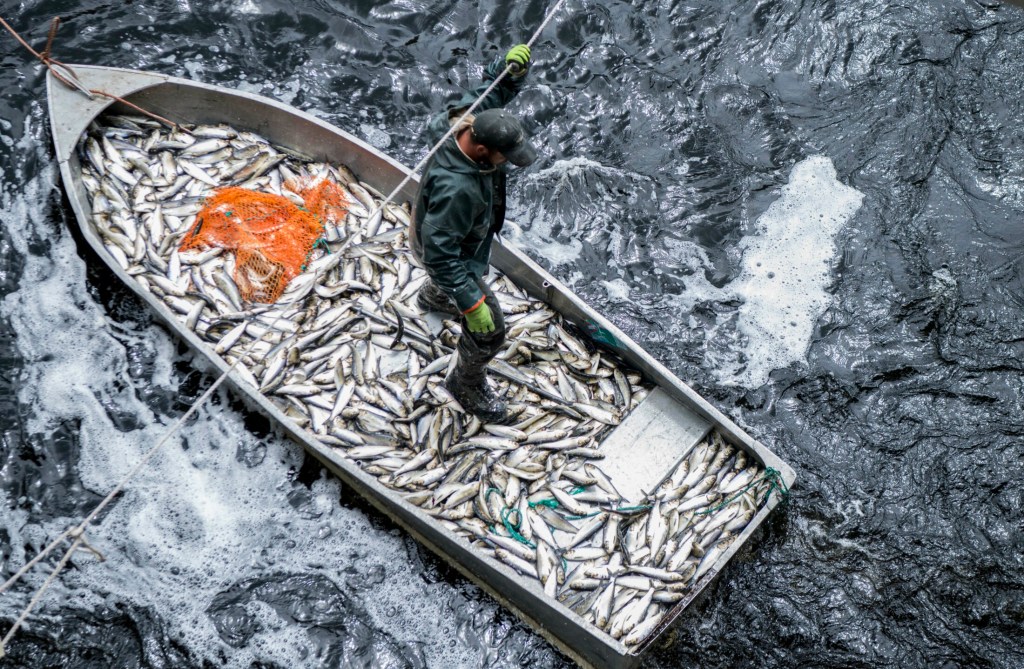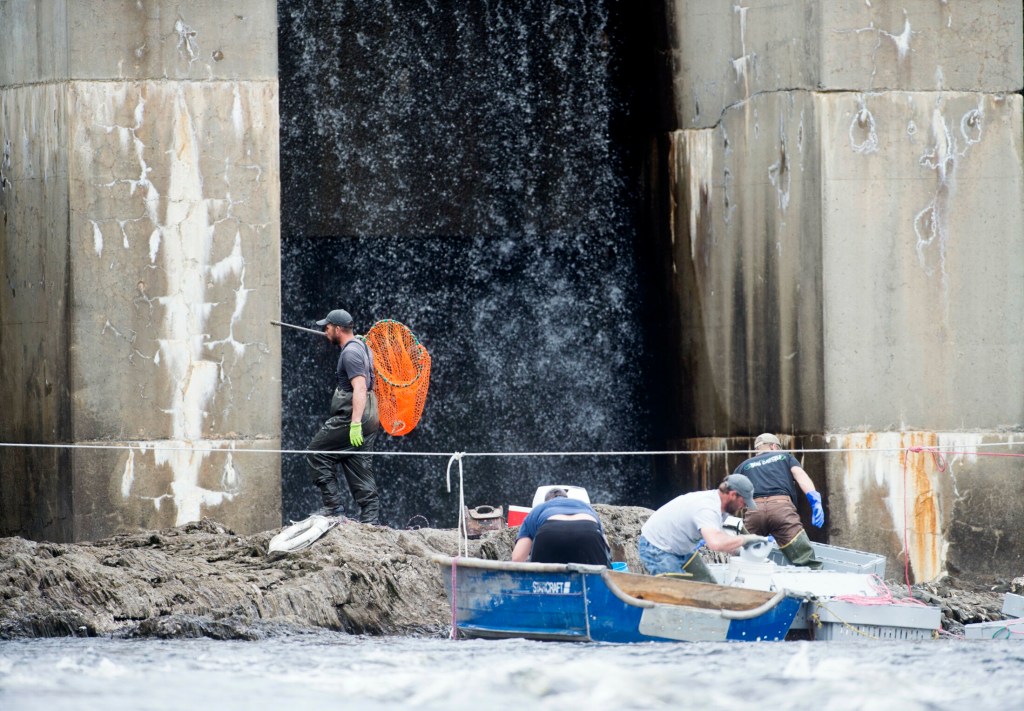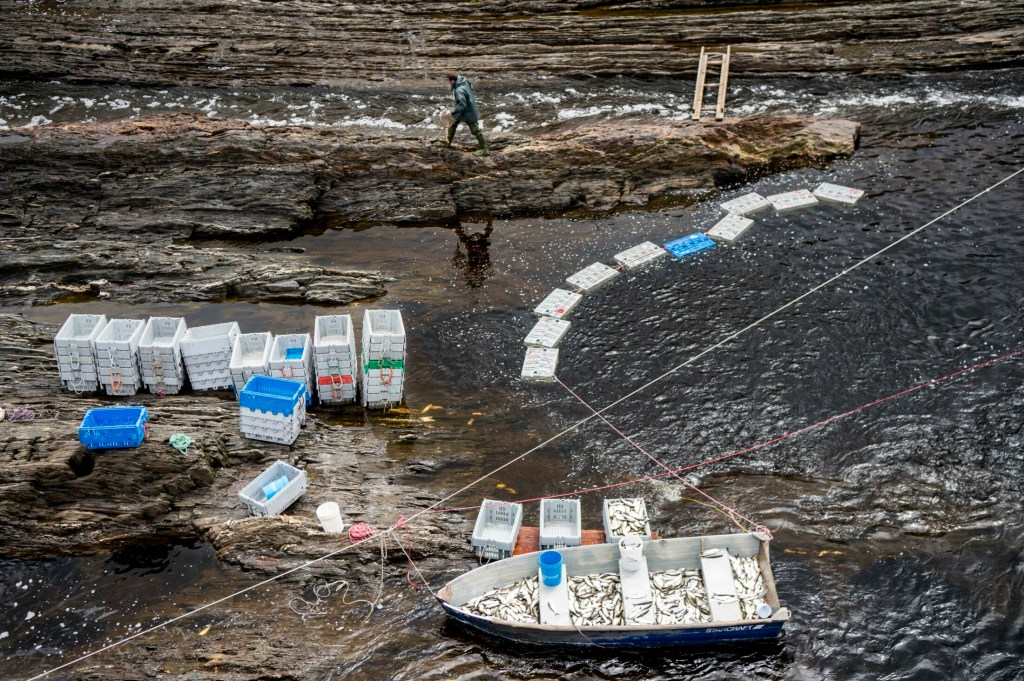BENTON — The sun was shining, music was playing and brightly colored paper fish decorated by local elementary school students greeted visitors to the eighth annual Benton Alewife Festival here on Saturday.
Nearby, at the Benton Falls Dam, fishermen waded through the Sebasticook River, filled with so many of the silvery fish that the alewives seemed almost to be jumping out of the water as they flapped against each other.
The harvesting season for alewives, which commonly are used as bait by Maine lobstermen, usually wraps up around June 1.
For the last several years, the town has organized a festival to celebrate the alewives’ remarkable comeback since the removal of two dams that previously blocked the fishes’ access to spawning grounds.
The explosion of the fish population at Benton Falls, estimated at just 400,000 in 2008, jumped to a record 5.7 million last year, which in turn is generating thousands of dollars from the harvest.
Meanwhile, the China Lake Alewife Restoration project is aiming to bolster the alewives’ spawning habitat even further in central Maine.
“It is really exciting to come here and see there is an alewife harvest taking place that’s connecting different parts of society together in a restoration story that’s absolutely remarkable on the East Coast of the United States,” said Landis Hudson, executive director of Maine Rivers, a nonprofit group focused on the ecological health of Maine’s rivers.
This summer marks 20 years since the removal of Edwards Dam on the Kennebec River in Augusta.
That dam removal, in combination with the removal of the Fort Halifax dam in Winslow in 2011, has made it possible for alewives to travel once again to the Sebasticook River to spawn — something that previously hadn’t been possible since the mid-1800s.
“Starting in 2008 when they took out that dam, suddenly all these fish were able to come up,” said Amy Gagnon, director of the Benton Alewife Festival. “It went from basically zero alewives to 200,000 to 1 million to 5 million.”
On Saturday, as part of the festival, visitors at the Benton Falls Dam could tour the fish elevator that brings the foot-long silvery alewives up and over the dam and watch as fishermen harvested them.
Nate Gray, a scientist with the Maine Department of Marine Resources, said of the 5.7 million fish that made it to the dam last year, about 650,000 of them were harvested by fishermen.
The total number included an increase of more than 2 million fish from the previous year, something Gray said can be attributed to two factors.
First, he said blueback herring, which are included in the department’s fish count at Benton Falls and make up about 20 percent of the population, have been surging in population and adding to the numbers.
Secondly, he said, a reduction in habitat for other species that eat the alewife, such as the Atlantic herring, means more alewives are surviving and making it upstream to spawn.
At Benton Falls, Gray said he doesn’t foresee the number of fish that make it over the falls to grow much beyond 5 million to 6 million, as there is a fixed amount of habitat and only so many fish can be supported.
But environmental groups nearby also are working on opening up China Lake to alewives, a process that will require the removal of dams or construction of fish passageways at six dam sites on a stretch of Outlet Stream in Vassalboro.
Two of those dams, Lombard Dam and Masse Dam, already have been removed as part of the China Lake Alewife Restoration Initiative, a project of Maine Rivers and partners including the Sebasticook Regional Land Trust, the Department of Marine Resources and others.
Hudson, the executive director of Maine Rivers, said Saturday there’s no firm timeline for the project’s completion, but the group does plan to install a fish ladder at Ladd Dam this summer and next year will look at a solution for a fourth dam, Box Mill Dam.
The benefits of restoring alewife spawning habitats are numerous, she said, and include not only the boost to the fish themselves but also the surrounding ecological environment.
Alewives are a common food source for other marine creatures, including larger fish and whales, as well as for animals and birds.
“It is true we have seen rebounding eagle and osprey populations,” Hudson said. “I’m quite sure the reason eagle populations are so much more robust than they were 30 years ago is because there’s more food in the river.”
People at Saturday’s festival also could sample smoked alewives for free, an offering that about 20 people had explored midway through Saturday’s event, said volunteer Justice Champagne, who was handing out the samples — each one consisting of an entire fish, including skin and eyes.
“From what I hear, they are quite bony,” Champagne said, “but I think most people like it.”
With the alewife harvest also comes an economic benefit. According to the department, the value of last year’s statewide harvest was $677,530.
Benton collects a portion of that money in exchange for the rights to fish the water, though the exact of what the town collected wasn’t available Saturday.
“It’s been quite an income in some ways for the town,” said Gagnon, the director of the festival. “It’s also become an attraction for visiting people, because of the eagles. People actually call the Town Office asking when they can come see eagles and when they’ll be out there for them to see.”
After last year’s alewife festival was canceled because of rain, Gagnon said it was important to residents to see it continue.
“It really is a great symbol for the area,” she said. “I think it’s an important thing for the town and we wanted to make sure it didn’t fade away.”
Send questions/comments to the editors.















Comments are no longer available on this story